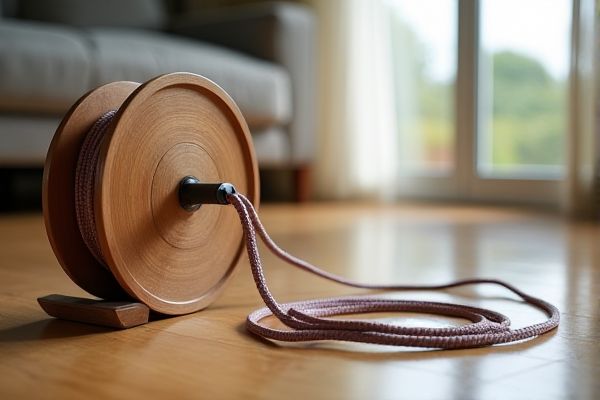
Choosing between a cord reel and a loose cord depends on your need for convenience, safety, and organization, as a cord reel provides tangle-free storage and easy reel-in functionality while a loose cord offers flexibility and quick access. Discover which option best suits Your setup by exploring the advantages and disadvantages detailed in the rest of this article.
Table of Comparison
| Feature | Cord Reel | Loose Cord |
|---|---|---|
| Storage | Compact, organized winding | Unorganized, prone to tangling |
| Portability | Easy to carry and transport | Bulky and inconvenient to move |
| Durability | Protected from damage and wear | Higher risk of damage and fraying |
| Safety | Reduced tripping hazards | Increased risk of trips and accidents |
| Usability | Quick deployment and retraction | Manual untangling and extension |
| Cost | Higher initial investment | Lower upfront cost |
Introduction to Cord Reel vs Loose Cord
Cord reels offer organized and tangle-free storage for electrical cables, enhancing safety and ease of use, especially in industrial and workshop settings. Loose cords, while flexible and readily accessible, often lead to clutter, increased wear, and higher risk of tripping hazards or electrical damage. Choosing cord reels improves cable longevity and workplace efficiency compared to managing loose cords without proper storage.
Key Differences Between Cord Reel and Loose Cord
Cord reels provide organized storage for cables, reducing tangling and extending cord lifespan through wound management, while loose cords often result in clutter and increased wear. Cord reels enhance safety by minimizing trip hazards and offer portability for mobile applications, unlike loose cords which can create disorganized workspaces. The key difference lies in the functionality: cord reels facilitate controlled deployment and retraction, whereas loose cords lack this feature, leading to potential operational inefficiencies.
Pros and Cons of Cord Reels
Cord reels offer organized cable management, reducing tangling and extending the lifespan of cords by preventing wear and tear. They enhance safety by minimizing tripping hazards and improve workspace efficiency through easy storage and quick access. However, cord reels may be bulkier and less flexible than loose cords, potentially limiting mobility and requiring periodic maintenance to ensure smooth retraction mechanisms.
Advantages and Disadvantages of Loose Cords
Loose cords offer greater flexibility in movement and easier access to power sources without the need for frequent plugging and unplugging. However, they pose a higher risk of tripping hazards, tangling, and potential damage to the cable's internal wiring over time. Unlike cord reels, loose cords lack organized storage, which can lead to clutter and reduced safety in both home and workplace environments.
Safety Considerations: Cord Reel vs Loose Cord
Cord reels enhance safety by preventing tripping hazards and reducing cord damage through organized storage, while loose cords increase the risk of accidents and electrical hazards due to tangling and wear. Using a cord reel ensures consistent tension control, minimizing strain on the cord's internal wiring and prolonging its lifespan. Your workspace remains safer and more efficient with cord reels, which are essential for maintaining proper cord management and preventing potential injuries.
Space Management and Storage Solutions
Cord reels offer efficient space management by neatly winding cables into compact housing, reducing clutter and preventing tangling. Loose cords, on the other hand, often create disorganized environments, making storage difficult and increasing the risk of damage. Implementing cord reels enhances storage solutions by optimizing available space and extending cable longevity.
Durability and Maintenance Comparison
Cord reels offer enhanced durability by protecting cables from wear, tangling, and environmental damage, significantly extending their lifespan compared to loose cords. Maintenance is simplified with cord reels, as cables remain organized and less prone to damage, reducing the need for frequent repairs or replacements. If you want to ensure reliable performance and minimize upkeep, opting for a cord reel is a practical choice for cable management.
Cost Analysis: Cord Reel vs Loose Cord
Cord reels typically incur higher upfront costs due to their durable casing and retractable mechanism, while loose cords are more economical initially but may require frequent replacement or tangle-related downtime, impacting long-term expenses. Maintenance costs are lower for cord reels as they prevent damage and enhance cord longevity, whereas loose cords pose risks of wear and tear from improper storage, increasing overall repair and replacement costs. Evaluating total cost of ownership favors cord reels for durability and efficiency despite initial price differences.
Best Use Cases for Each Option
Cord reels offer organized storage and easy retraction, making them ideal for work environments requiring frequent cable mobility, such as construction sites and workshops. Loose cords provide flexibility and accessibility, suitable for stationary setups like home offices or entertainment systems where cables rarely need to be moved. Choosing between cord reels and loose cords depends on the need for portability versus convenience in fixed installations.
Conclusion: Choosing the Right Cord Management Solution
Cord reels offer organized, space-efficient storage that reduces tangling and potential damage, making them ideal for frequent use and mobility. Loose cords may provide quick access but increase risks of wear, clutter, and safety hazards in your workspace. Selecting the right cord management solution depends on your specific needs for convenience, durability, and safety.
 homyna.com
homyna.com